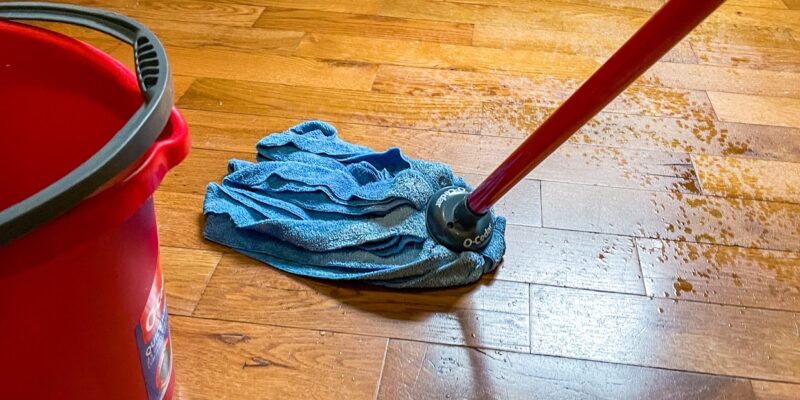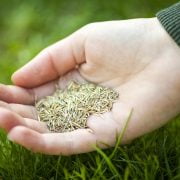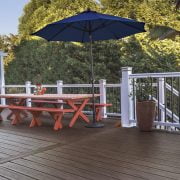Hardwood floors add warmth, elegance, and value to any home. However, they are susceptible to damage from water and moisture. Whether it’s spills, leaks, or high humidity levels, water can wreak havoc on hardwood floors, leading to warping, discoloration, and even mold growth.
To preserve the beauty and longevity of your hardwood floors, it’s essential to take proactive steps to protect them from water damage. In this article, we will discuss some valuable tips to safeguard your hardwood floors from water.
Clean Up Spills Immediately
One of the simplest yet most effective ways to protect hardwood floors from water damage is to clean up spills promptly. Water can seep into the wood’s pores and cause it to expand, leading to warping or cupping.
Whenever there’s a spill, use a soft, absorbent cloth or paper towel to blot the liquid immediately. Avoid rubbing the spill, as it can spread the water and push it deeper into the wood. Once you’ve removed the excess moisture, dry the area thoroughly using a fan or a dry cloth.
Place Mats and Rugs Strategically
Strategic placement of mats and rugs can act as a barrier between water sources and your hardwood floors. Use doormats at all entry points to capture dirt, debris, and moisture from shoes before it reaches the floors.
Additionally, consider using rugs or mats in high-traffic areas, such as the kitchen or bathroom, where spills are more likely to occur. Opt for mats with non-slip backing or rug pads to prevent them from sliding and causing accidents.
Wipe Shoes and Pet Paws
Shoes and pet paws can track in moisture from outside, which can damage your hardwood floors over time. To prevent this, make it a habit to wipe your shoes thoroughly on a mat or remove them before entering your home.
Similarly, keep a towel or pet wipes near the entrance to wipe your pet’s paws before they walk on the hardwood floors. This small but effective measure can significantly reduce the amount of water and dirt that makes its way onto your floors.
Control Humidity Levels
Excess humidity can lead to moisture buildup in the air, which can be detrimental to hardwood floors. High humidity levels can cause wood to absorb moisture and swell, resulting in buckling or cupping. To prevent this, invest in a hygrometer to monitor the humidity levels in your home.
Ideally, the humidity should be maintained between 35% and 55%. If the levels exceed this range, use dehumidifiers to reduce moisture in the air. Additionally, ensure proper ventilation in rooms prone to high humidity, such as bathrooms and kitchens.
Seal Gaps and Cracks
Gaps and cracks in your hardwood floors can be entry points for water and moisture. Regularly inspect your floors for any openings and promptly seal them with an appropriate wood filler or sealant.
Pay close attention to areas near sinks, toilets, and other water sources, as they are more vulnerable to water damage. By sealing these gaps, you create a barrier that prevents water from seeping into the wood, reducing the risk of damage.
If you require professional assistance in maintaining the quality of your hardwood floors, consider hiring a reliable hardwood sanding service. They can help in refinishing your floors, repairing any existing damage, and providing expert advice on how to prevent water damage in the future.
Use Protective Coatings
Applying a protective coating on your hardwood floors can provide an extra layer of defense against water damage. Polyurethane, epoxy, or wax coatings can create a water-resistant barrier that helps repel spills and moisture.
Before applying any coating, ensure that the floors are thoroughly cleaned and properly prepared. Follow the manufacturer’s instructions for application and maintenance to ensure the coating’s effectiveness and longevity.
Regular Maintenance and Inspection
Regular maintenance and inspection of your hardwood floors are crucial to identifying potential water damage early on. Periodically check for signs of discoloration, warping, or buckling on the surface of the floors. Look for water stains or dark spots, as they indicate water penetration.
If you notice any signs of water damage, address them promptly to prevent further deterioration. Additionally, follow a routine cleaning schedule to keep your floors free from dirt and grime, as they can attract moisture and accelerate damage.
Use Floor Mats in Wet Areas
Certain areas of your home, such as the kitchen, bathroom, or laundry room, are more prone to water spills and leaks. To protect your hardwood floors in these wet areas, consider using waterproof floor mats or trays.
Place them near sinks, toilets, or washing machines to catch any water that may escape. These mats provide an added layer of protection, preventing water from seeping into the hardwood floors and causing damage.
Be Cautious with Cleaning Methods
When cleaning hardwood floors, it’s important to use caution to avoid excess water exposure. Excessive moisture from mops or steam cleaners can seep into the wood and lead to damage. Instead, opt for dry or slightly damp microfiber mops to clean your hardwood floors.
Avoid using excessive amounts of water and harsh cleaning solutions that can strip away the protective finish. Always refer to the manufacturer’s guidelines for recommended cleaning methods and products.
Act Quickly in Case of Water Damage
Despite your best efforts, accidents can still happen, and water damage may occur. In such cases, it’s crucial to act quickly to minimize the impact. If you experience a significant water spill or a leak, immediately remove the water using a wet vacuum or mop.
Thoroughly dry the affected area and monitor it closely for any signs of damage. If necessary, consult a professional water damage restoration service to assess the situation and provide the appropriate remedies.
Summary
Protecting your hardwood floors from water damage is essential for maintaining their beauty and longevity. By implementing the tips mentioned above, you can safeguard your floors against the detrimental effects of water and moisture.
Remember to clean up spills promptly, strategically place mats and rugs, control humidity levels, seal gaps, and cracks, apply protective coatings, and conduct regular maintenance and inspections. By following these preventive measures and being proactive in addressing any water damage, you can enjoy the timeless beauty of your hardwood floors for years to come.














Comments